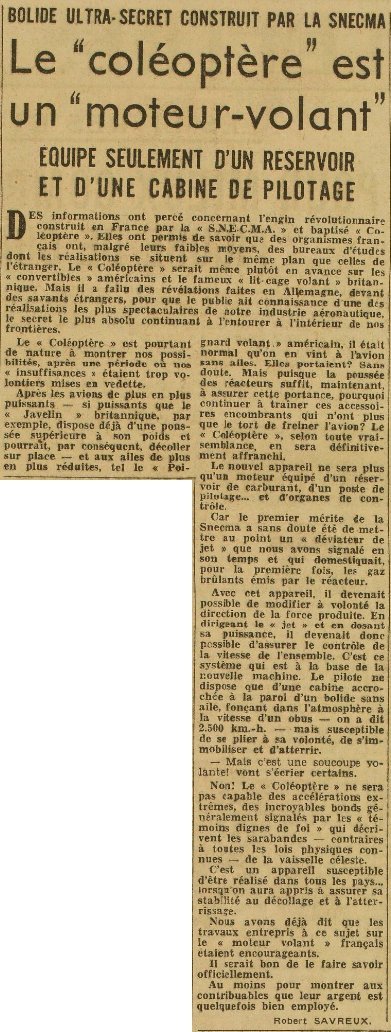The article below was published in the daily newspaper Franc-Tireur, Paris, France, page 5, October 21, 1954.

|
Information has leaked regarding the revolutionary craft built in France by S.N.E.C.M.A. and dubbed the "Coléoptère." These revelations show that French organizations, despite limited resources, operate design offices capable of achievements on par with international efforts. In fact, the "Coléoptère" may even be ahead of American convertiplanes and the British "flying bedstead." Yet it took disclosures made in Germany, before foreign scientists, for the public to become aware of one of the most spectacular accomplishments of our aeronautical industry. Absolute secrecy still surrounds it within our own borders.
The "Coléoptère" is, however, something that showcases our potential, at a time when our "shortcomings" have too often been highlighted.
After increasingly powerful planes—so powerful, for instance, that the British "Javelin" already produces more thrust than its own weight and could theoretically lift off vertically—and increasingly reduced wings, such as on the American "Flying Dagger" [Delta Dagger], it was only logical to arrive at the wingless plane. Did wings provide lift? Certainly. But since jet thrust now suffices for lift, why keep these bulky accessories that only serve to slow the aircraft? The "Coléoptère" will likely be rid of them once and for all.
The new craft will be little more than an engine equipped with a fuel tank, a cockpit... and control systems.
Snecma's greatest contribution may have been the development of a "jet deflector" we once reported on—an innovation that, for the first time, tamed the searing gases emitted by a jet engine.
With this device, it became possible to direct the thrust and control its power output. This in turn allowed precise control of the craft's velocity. That system forms the foundation of this new machine. The pilot sits in a cockpit attached to the side of a wingless projectile hurtling through the atmosphere at shell-like speeds—reportedly up to 2,500 km/h—yet able to respond to commands, slow down, and land.
"But that's a flying saucer!" some may exclaim.
No! The "Coléoptère" won't be capable of the extreme accelerations or the incredible leaps typically reported by "credible witnesses" describing the antics—defying all known physical laws—of celestial crockery.
It's a craft that any nation could eventually build... once the problem of stabilizing vertical takeoff and landing is solved.
We've already said that the work underway on the French "flying engine" is encouraging.
It would be wise to announce it officially.
At the very least, to show taxpayers that their money is occasionally well spent.
Robert SAVREUX.